Last Updated on: February 5, 2025
Did you know that New Hampshire has over 300 bird species? Yes, it’s an excellent destination for birders hoping to see a diverse range of species, from birds of prey to songbirds and thrushes.
And…
Since it’s impractical to include all birds in New Hampshire in this article, we’ll discuss common species you can spot in a city park, on the deck in your backyard, or in woodlands.
Make it easier to explore this birdlife by listing field markings on your journal and collecting pictures to compare bird size, shape, and plumage. Read on!
Common Birds Of New Hampshire You Should Know By Now
When we talk about common birds, we mean the ones you’ll see throughout the year, or at least during one season, such as the breeding season. They include:
1. American Robin
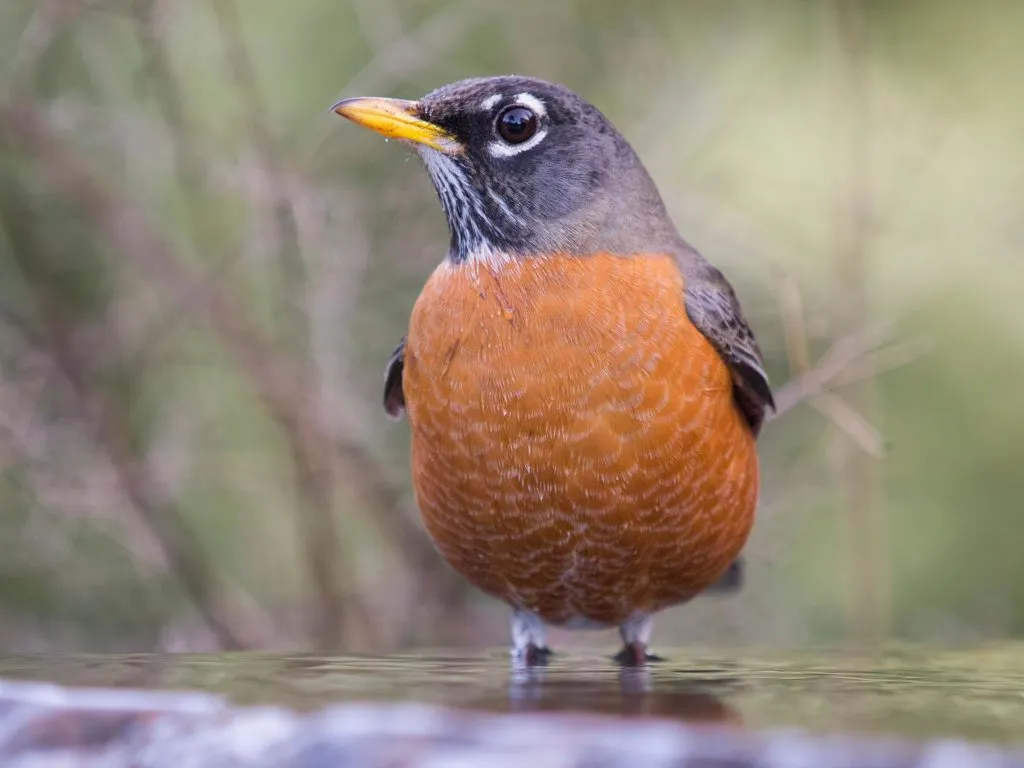
To start us off is a species that visits backyards often, looking for earthworms and other invertebrates.
This medium-sized bird is easy to ID by its plumage because it has earthy coloration comprising a rusty red underbelly and a black back. The only bright spots are its white eye splotches and yellow bill.
The only way to tell a male from a female robin is by looking at the overall color pattern as a female is paler.
This species is a thrush, just like bluebirds. New Hampshire is in its resident range, which means you’ll see robins any day of the year, and in many habitats because robins live everywhere.
They don’t fear nesting near humans; hence, they’re probably responsible for the cup-shaped nests perched on horizontal branches in your yard.
2. Downy Woodpecker
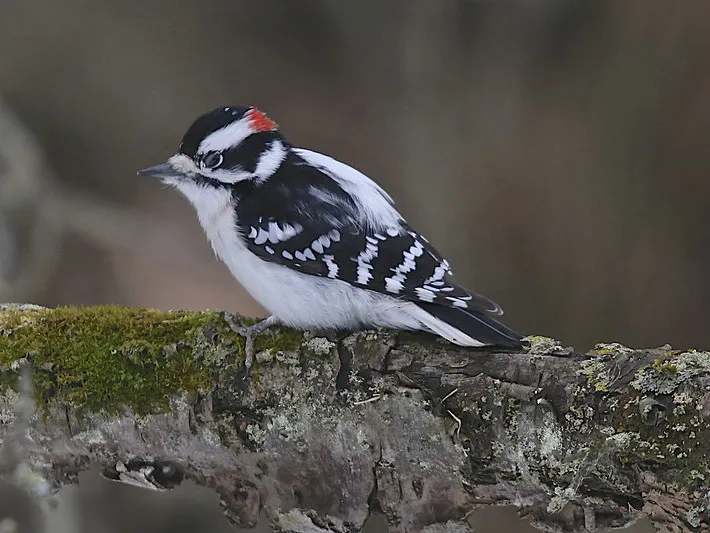
A downy woodpecker is about half the size of an American robin. You’ve probably seen it in your backyard or when exploring a city park, as it’s one of the most common species in North America, seen in all regions except some southwestern states.
Downy woodpeckers are easy to recognize. They have a red patch on the nape, contrasting black and white heads, and white spotted black wings. However, the female bird doesn’t have this red patch.
If you don’t have enough downy woodpeckers visiting your backyard feeder, you can attract them using suet, peanuts, and sunflower seeds. They also love the nectar in hummingbird feeders.
3. Hairy Woodpecker
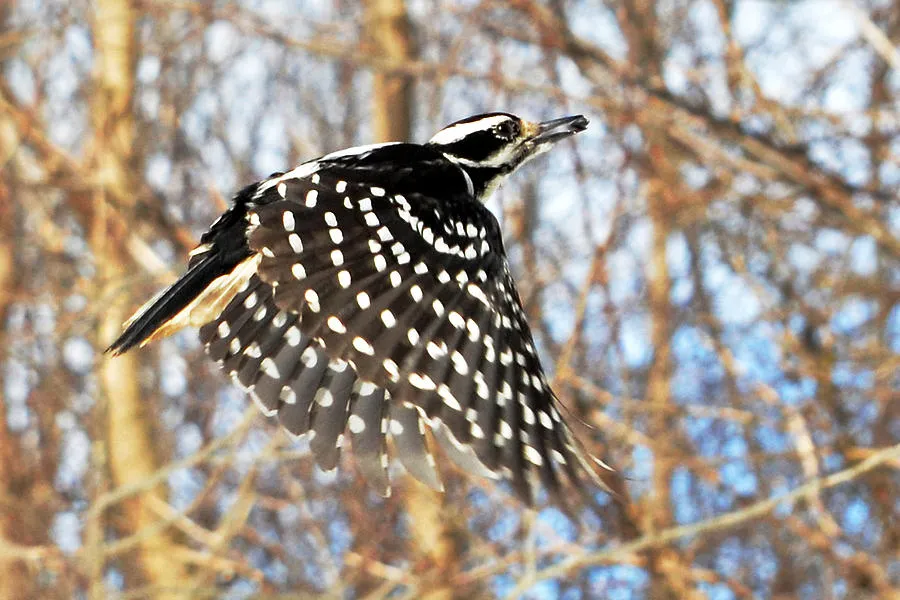
A hairy woodpecker has similar plumage to a downy, even the red patch on a male’s head. But, when you see the two species side by side, you notice that the outer tail feathers of a downy woodpecker have black spots, while those on a hairy woodpecker are plain white. Also, a hairy woodpecker has a longer bill.
Another way to tell them apart when they are close together is by their size because a hairy measures 9 to 11 inches, whereas a downy is about 6 to 7 inches long. Hairy woodpeckers are also prevalent in North America in a similar pattern range as the downy woodpeckers since they don’t have a population in the southwestern states.
4. American Goldfinch
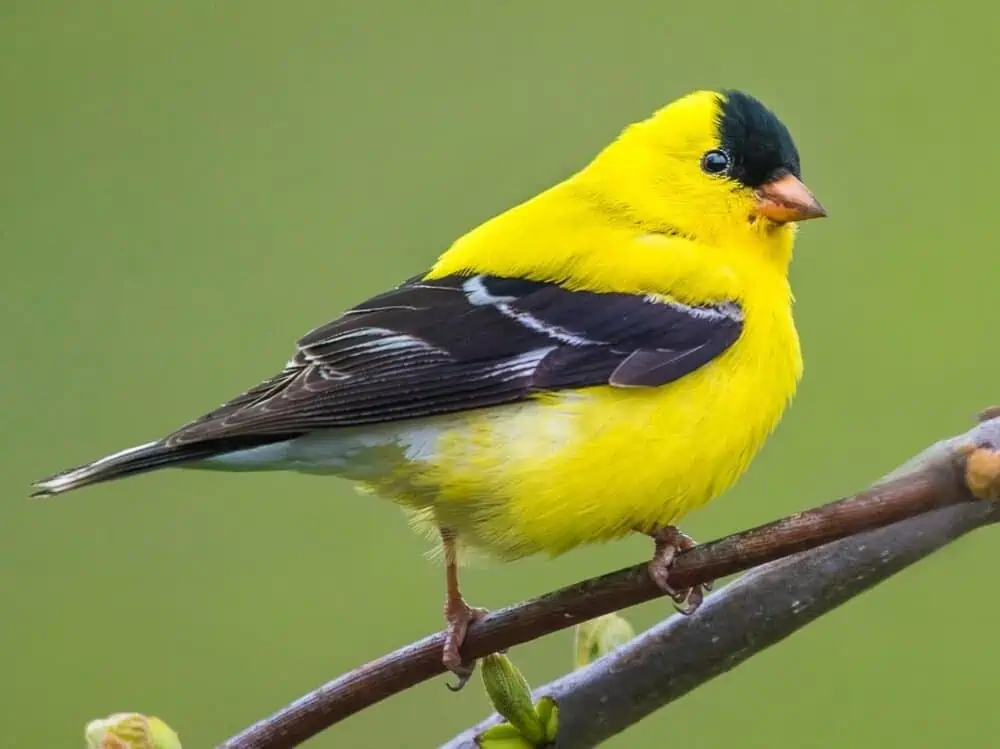
An American goldfinch has one of the most stunning colors, displaying a vibrant yellow body with black wings and a black cap. A female doesn’t have a striking black head cap like a male bird and has an olive-green body. Nevertheless, both birds lose this stunning plumage in winter to acquire a more pale brown-olive body.
New Hampshire is in the resident range of this species, meaning you’ll see it throughout the year. Parts of North America with a migratory population are the northern region, where they breed and fly south to wintering grounds in states like Florida and Texas.
American goldfinches visit bird feeders for sunflower seeds, nyjer, or weed seeds. They are among the few backyard birds that don’t eat insects.
5. House Sparrow
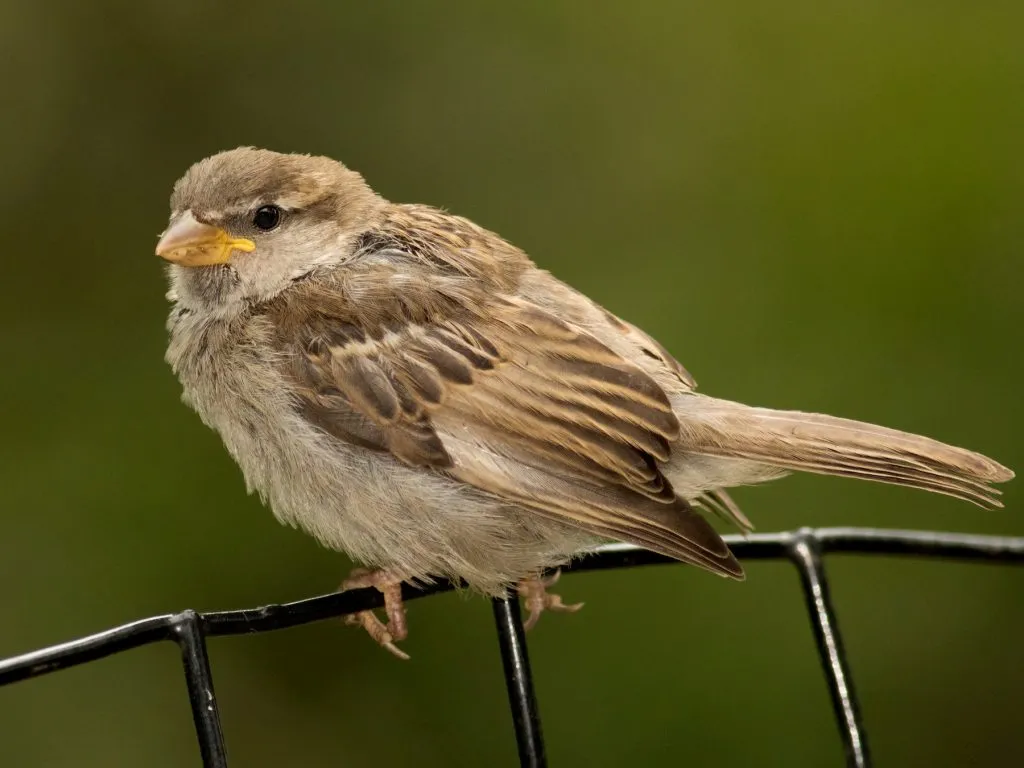
House sparrows are everywhere in North America, so you’ll also see them in New Hampshire. They aren’t as bright as American goldfinches.
A male house sparrow has a dark gray crown, a black bib, and a brown back with black streaks. On the other hand, a female has a light brown underbelly, a dull brown back streaked black, and a tan line running from its eye to the back of the head.
House sparrows eat a wide range of bird food, and when that’s not available, they snack on human food like bread. That’s one of the reasons they live everywhere on this continent.
6. House Finch
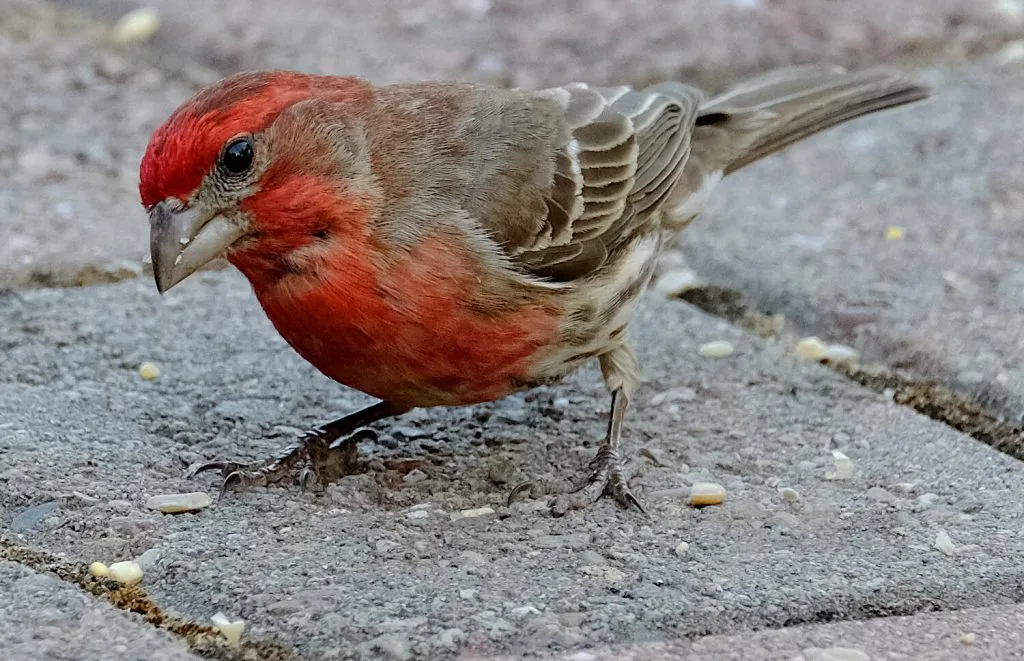
The thing I love most about finches is how easy they’re to identify. The male bird has a striking rosy face and chest that differentiates it from a house sparrow if the streaking on the back ever makes you confuse the two species.
Secondly, both finch sexes have streaks on their chests and tails, plus a characteristic conical bill suited to seeds.
Like other birds listed so far, house finches are resident avians in New Hampshire throughout the year. Plus, you don’t have to go far to look for them, as they love the laid-back lifestyle of flying into backyards for black oil sunflower seeds, nyjer, or safflower.
If you don’t have a bird feeder yet, you can watch out for house finches in a nearby park, where you’ll come across flocks of them.
Once you set up a feeder and need backyard birds to know about it, they’ll come over as soon as house finches take note because their noise and sheer number grab the attention of other birds.
7. Brown-headed Cowbird
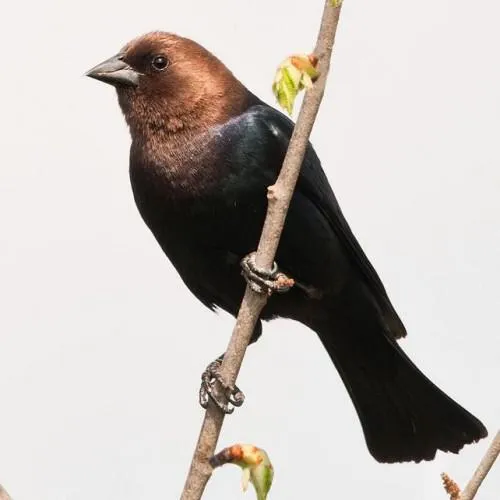
A male bird has the glossy plumage of an American crow except for its dark brown head. A female isn’t glossy black as its back has brown streaks, while its underbelly is plain brown.
When it comes to size, a brown-headed cowbird is about half the size of an American crow.
The northern region of this state is in the breeding range that extends into Canada, while the resident birds in New Hampshire inhabit the southern side.
Among the habitats that this bird loves include grasslands, brushy thickets, and edges of woodlands. But beyond these natural habitats, you’ll also find them in cemeteries and residential areas.
These blackbirds aren’t your usual backyard visitors because when they show up, they bring along their parasitic habit of laying eggs in the nests of other birds, so that other female birds can take care of their nestlings.
8. American Crow
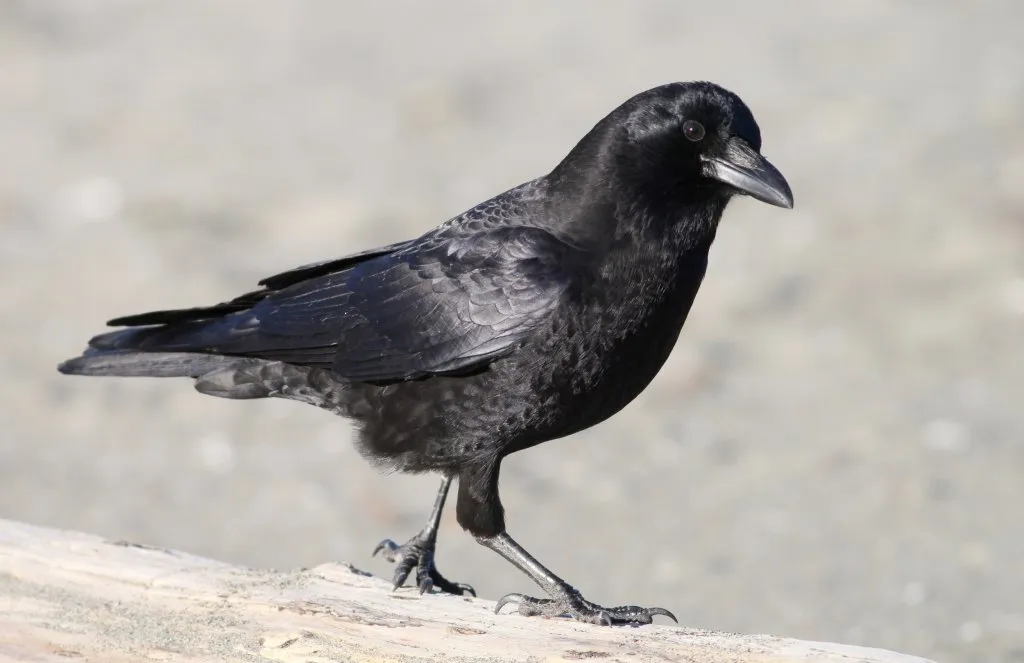
Outside the birding world, you barely hear anything good about American crows. These glossy black birds adapt to any environment, and that’s why they inhabit farms, woodlands, cemeteries, and residential areas. They don’t visit backyards for bird seed, but you might see them picking a few peanuts and kernel corn.
American crows are resident birds in this state, like most of the United States. The breeding range is on the northern side, in parts of Canada.
An American crow is an intelligent bird to have in your backyard, and it’s also interesting to listen to as it makes a range of sounds, from caws to rattles and crackles.
9. European Starling
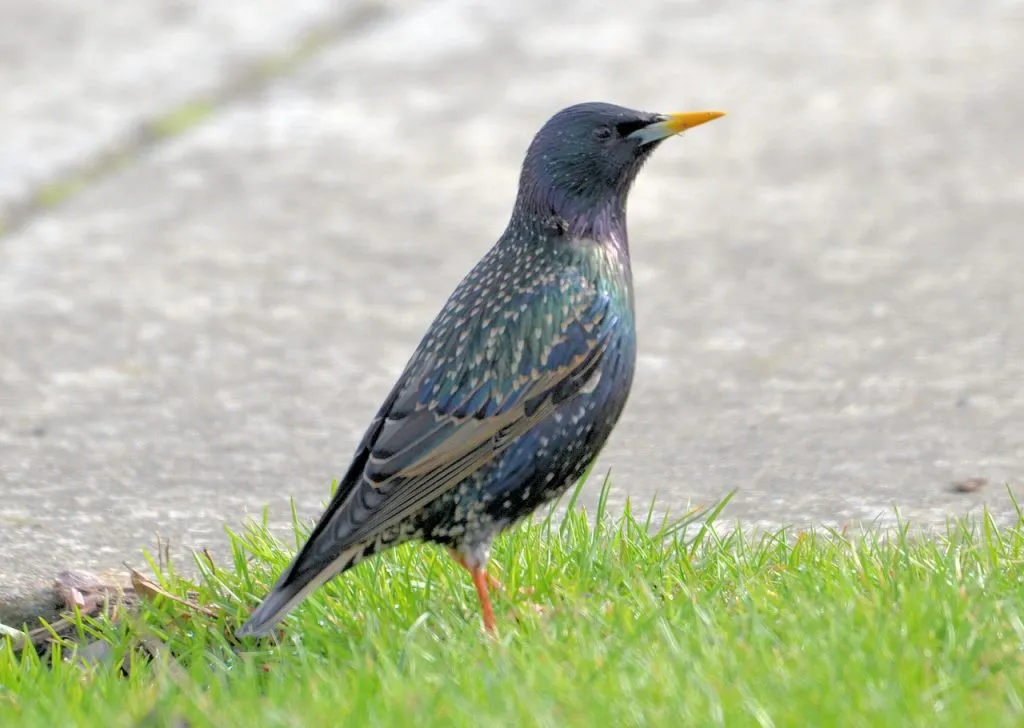
If you aren’t familiar with the European starling, it’s the shiny bird with a green-purple tint and a yellow bill. Its plumage changes in winter to acquire white spots on a less glossy body, and its bill darkens.
European starlings are as common in New Hampshire as in other states because there are resident birds throughout North America. It’s that invasive. No one imagined that introducing this species in New York in the late 1800s would fill all states with starlings over 100 years later.
One reason for this bird’s growing population is that it adapts to any environment and eats many foods. When supply is scarce, it fights for the little bird food you will offer with other backyard birds, sometimes chasing away the smaller ones.
You need several bird feeders to keep European starlings and smaller birds like chickadees around your backyard.
10. Red-winged Blackbird
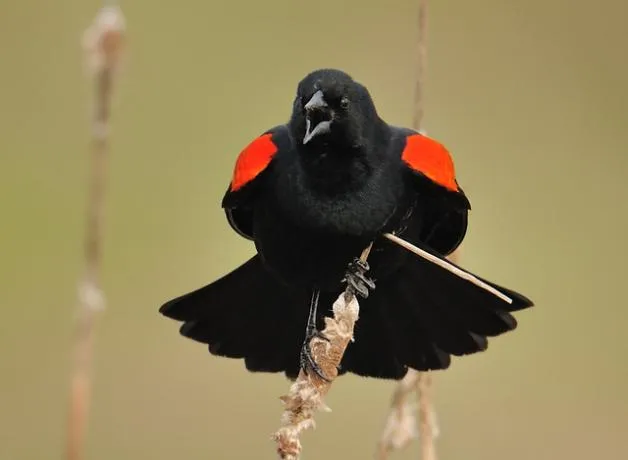
The only difference between an American crow and a red-winged blackbird is the orange shoulder patch on a male red-winged blackbird. A female blackbird has a brown body with heavy streaks and a yellowish patch around the bill.
These blackbirds live in marshes and other wet habitats. During the breeding season, they move to dense vegetation like bulrushes and sedges.
The males are very aggressive when protecting their nests; there have been cases where they attack humans who come close to their nests.
After the breeding season, you find this species having a good time in the grasslands or looking for weed seeds in farm fields. Sometimes, they do all this in the company of other species like grackles and starlings.
11. White-breasted Nuthatch
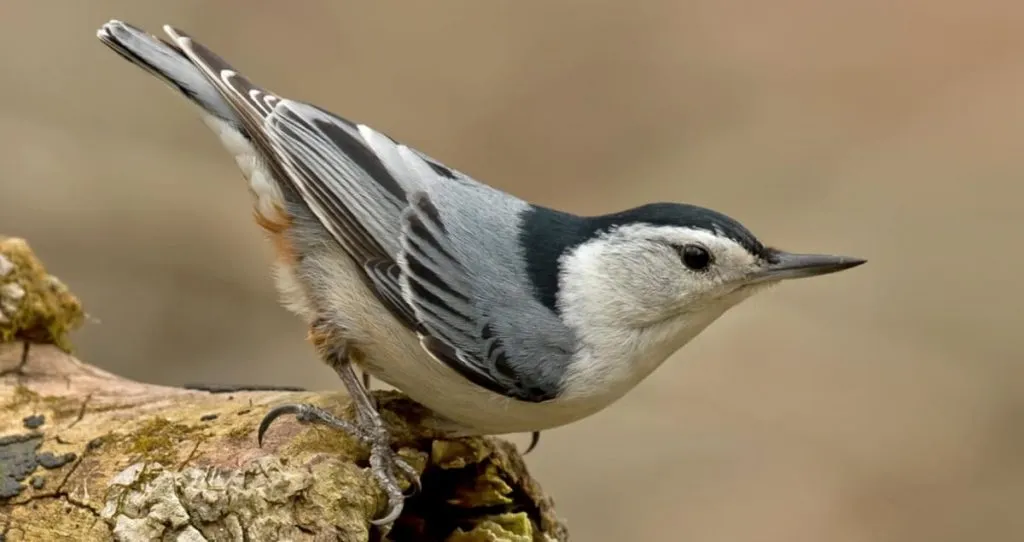
This tiny species has no neck, and its tail is short. However, it has a long pointy bill suited to a wide range of foods in bird feeders, such as sunflower seeds and peanuts. It also loves mealworms.
When there’s no feeder around where nuthatches can get sumptuous treats, they visit deciduous forests, cemeteries, and parks.
The white-breasted nuthatch is a common species throughout North America, with a resident population in almost every state.
When you see a group of white-breasted nuthatches, you can differentiate the male from the female by the crown because a male has a black one, while that of the female is bluish-gray.
Overall they have the same body plumage, which comprises white cheeks, a white underbelly, and a bluish-gray back.
12. Song Sparrow
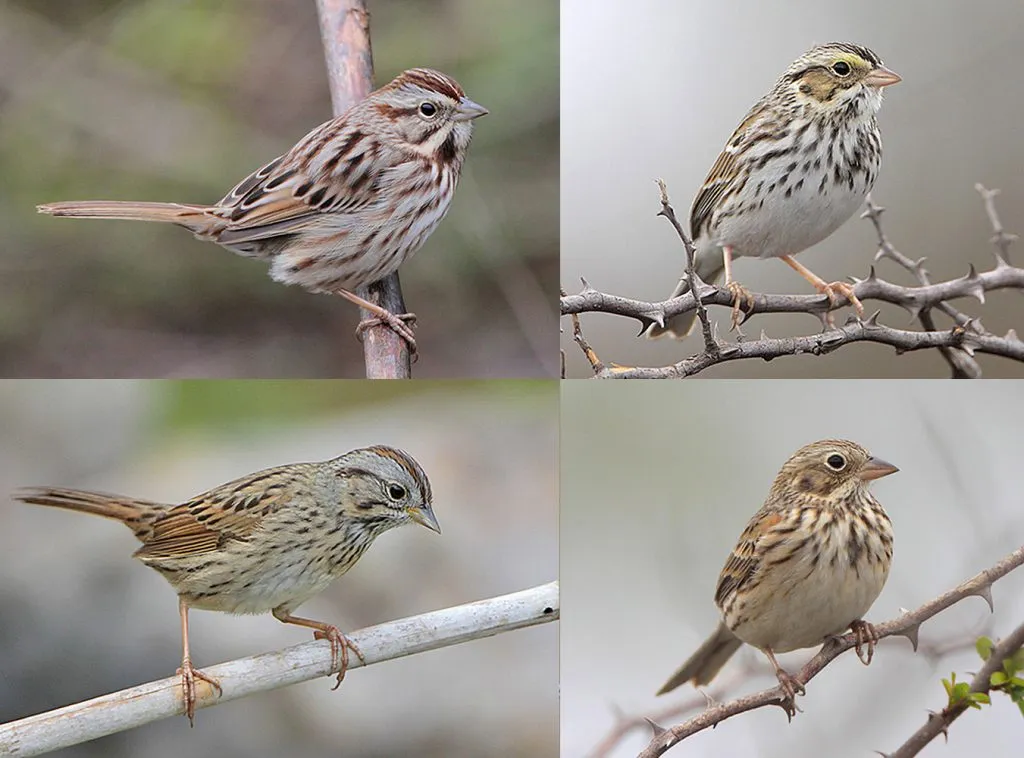
Generally, sparrows have almost similar plumage. Here’s what can help you identify song sparrows. Both sexes have brown streaks on their chests that start at a central spot. They also have alternating gray and brown stripes on the head.
New Hampshire is in the bird’s resident range, but the northeastern edge is in the breeding range. If this species doesn’t come to your backyard, search for it in shrubby fields or look for song sparrow nests in weeds and grasses.
13. Ruby-throated Hummingbird
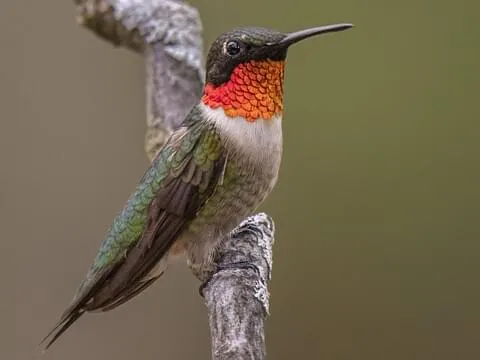
The most striking feature of a ruby-throated hummingbird is its long bill, which is different from other species like the sparrows and finches.
Additionally, it has vibrant plumage colors as the male has an iridescent green back and a red throat. On the other hand, a female bird has subdued coloration because instead of red and green colors, it has a white throat, a white underbelly, and a green-colored back.
It’s not a resident in New Hampshire as this and other states on the eastern side are in the breeding range.
You’ll likely see this hummingbird in the summer months before it migrates to Mexico and the tip of Florida, where it winters.
14. Baltimore Oriole
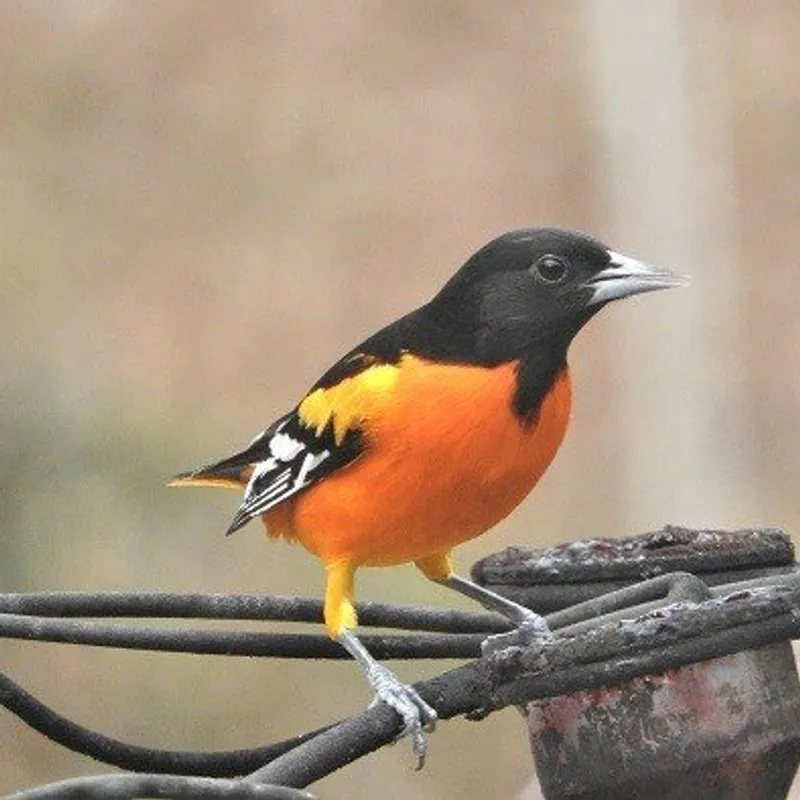
Without a doubt, Baltimore orioles are stunning birds. The females are duller and lack a black hood and black wings, but they’re still striking.
You know it’s spring again when you see these orange birds with white wings around your nectar feeder. The eastern states are in the breeding range.
Therefore, set up your nectar feeder when you spot these avians in New Hampshire to invite as many nesting birds as possible. In addition to sugar water, Baltimore orioles also love fruit and jelly.
Combining these foods gives them enough energy for the long migration to their wintering grounds in Florida and the Caribbean. Plus, they’re very active, fluttering around looking for materials for their nests.
Look for them in habitats like open woodlands, forest and swamp edges, or along riverbanks. You’ll rarely see them in dense forests, and they prefer to live high up in the trees, so you’ll hear them before you see them.
15. Eastern Bluebird
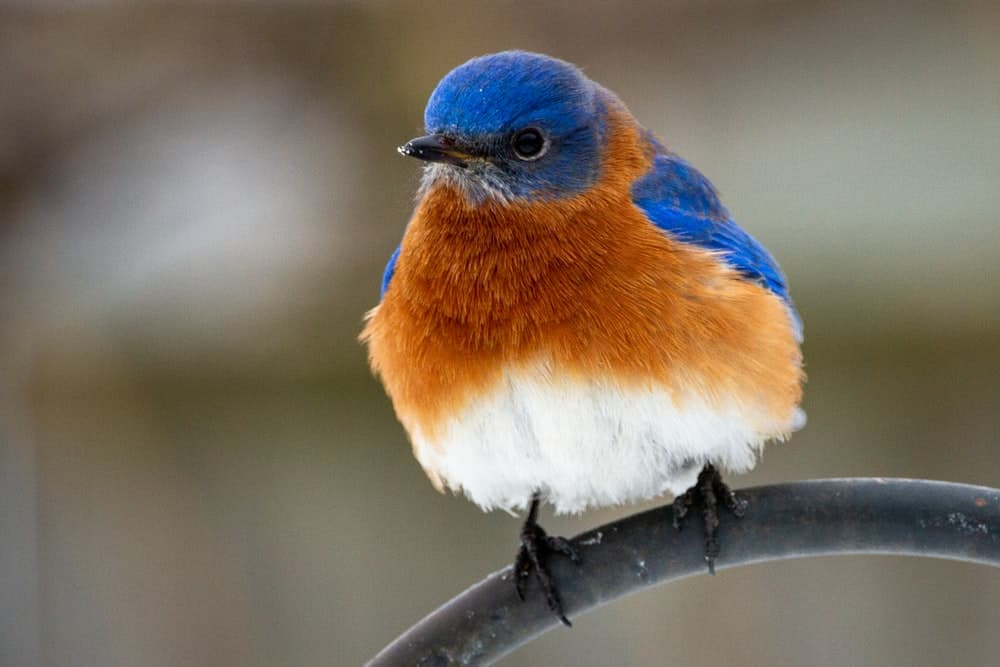
Eastern bluebirds love bird feeders with mealworms and berries. They also don’t mind getting a nest box in your backyard. If there are no eastern bluebirds in your backyard, look for them in nearby parks, fields, or cemeteries. They also love golf courses; thus, you might spot blue-colored birds in the trees alongside the manicured lawns on a golf course.
An eastern bluebird must be among the easiest to identify because it has three plumage colors only. Its back is blue, its throat and chest are rusty, and its underbelly is white.
A female eastern bluebird has the same color pattern, although subdued. It’s an eastern species, with the southern side of New Hampshire hosting the resident birds while the rest of the state is in the breeding range.
16. House Wren
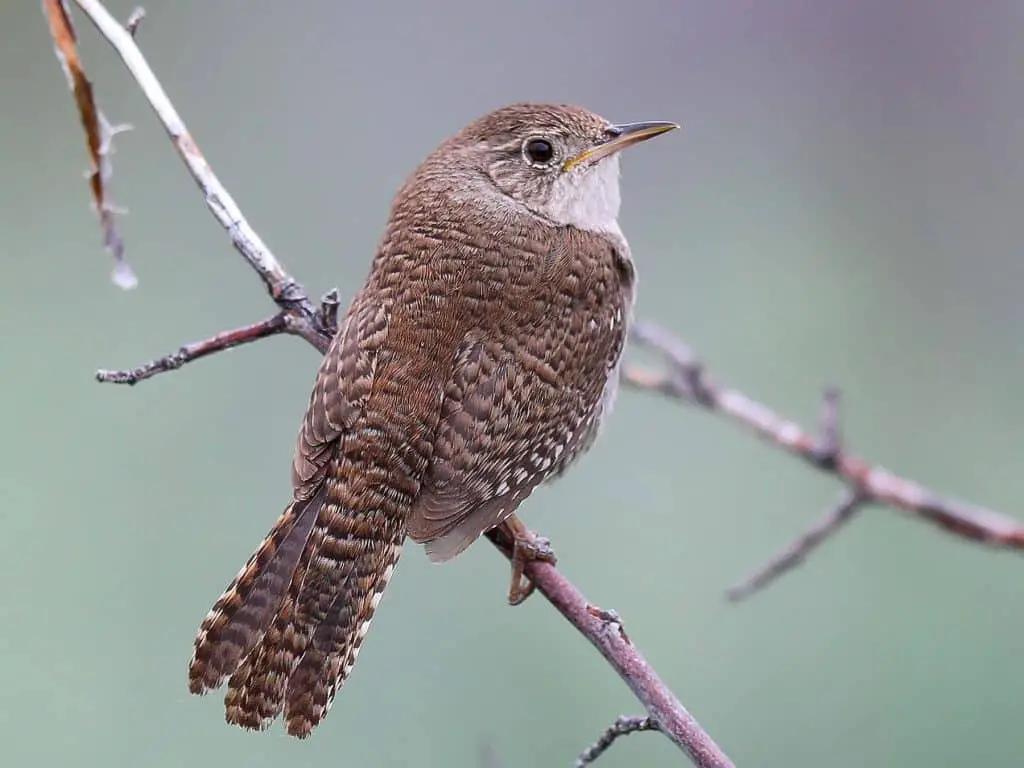
It’s not a regular backyard visitor, but since you’ll go birding away from home, put it on your list so you can remember its field marks.
Here are some of the features to help you ID it. A house wren has dark bars on its wings and tail, and it’s a tiny bird with a brown body. Its bill is thin compared to other species, such as the brown-headed cowbird. Fortunately, both sexes have the same plumage, so once you see one bird, you’ve seen them all.
House wrens love insects. The few times you might see them on your property, they’ll be chasing insects through your yard. You can use that to your advantage and plant brush piles that’ll bring insects to your yard.
New Hampshire falls in the wren’s breeding range, so these birds eventually migrate to their wintering grounds in the southern states like Florida and Texas.
17. Blue Jay
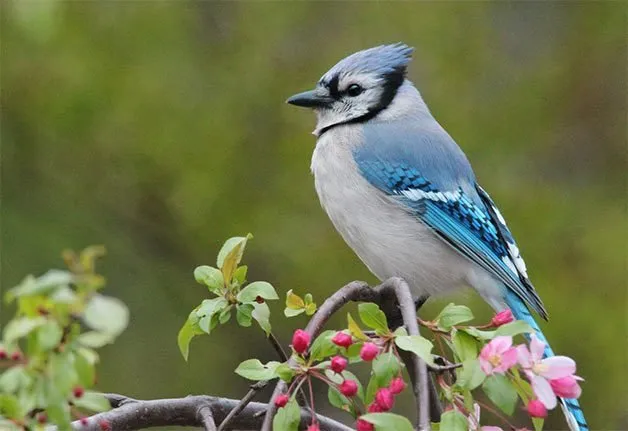
If there’s one thing I love about blue jays, it’s their beauty. They’re beautiful, bluish birds with a thick black band around the neck of the male birds and an upright blue crest. Their wings have a colorful pattern of black, white, and blue feathers that can make any fashion couture addict jealous.
Is a jay’s personality as stunning as its body? Uhm! We can say that a blue jay is intelligent, as it can mimic hawks. But, this species is too much to handle for the smaller species as blue jays dominate feeders. You have to get separate feeders for jays and species like northern cardinals.
Lastly, blue jays are everywhere in the eastern states, including NH, throughout the year.
18. Mourning Dove
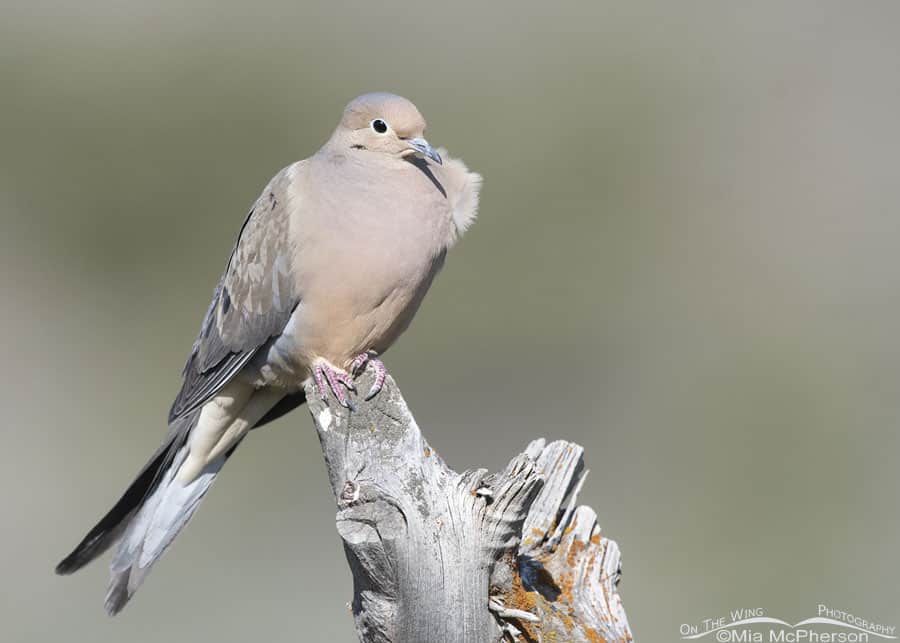
The medium-sized birds that invade your yard in dozens, with pink legs and plump, gray bodies, are mourning doves. When you look closely, you realize their gray wings have black spots, and their eyes are in a blue eye ring. You’ve probably also heard their mourning call.
To keep mourning doves around, put some millet, cracked corn, or safflower on a platform or tray feeder. If they ignore your effort, scatter some of that food on the ground where they love feeding.
19. Rock Pigeon
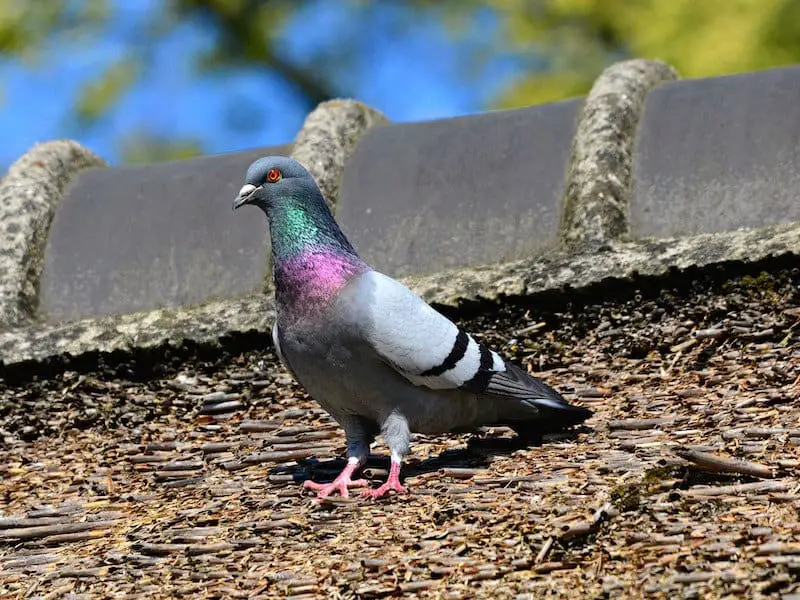
Right after talking about doves, here’s another species with similar plumage and behavior. Rock pigeons love flocks; thus, they come to overwhelm and occupy your yard.
The plump birds you see daily, with bluish-gray small heads, grayish backs, and short legs, are rock pigeons. They also spot two thick wing bars. However, plumage colors vary, so the ones you see might be rusty brown or whitish.
This species is everywhere in North America, from parks to backyards. If your property doesn’t have feeders, you’ll see rock pigeons enjoying your leftovers when you leave your bins open.
20. Northern Cardinal
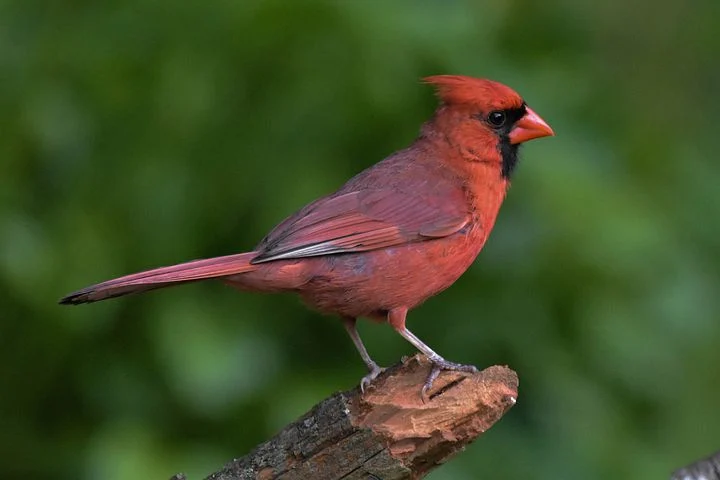
Cardinals are stunning because of their crested heads and bright plumage. Even though females don’t have red bodies like male cardinals, their orange-brown bodies differ from all the streak and blue plumage mentioned on this list.
Northern cardinals aren’t demanding as they’re comfortable feeding on the ground if you don’t set up a feeder for them. Just scatter peanuts or black oil sunflower seeds.
Further, the northern cardinal is one of the species only found in one side of North America, in the eastern and some southwestern states. Therefore, you’re lucky to be birding in NH, as you’ll see a northern cardinal almost daily throughout the year.
21. Black-capped Chickadee
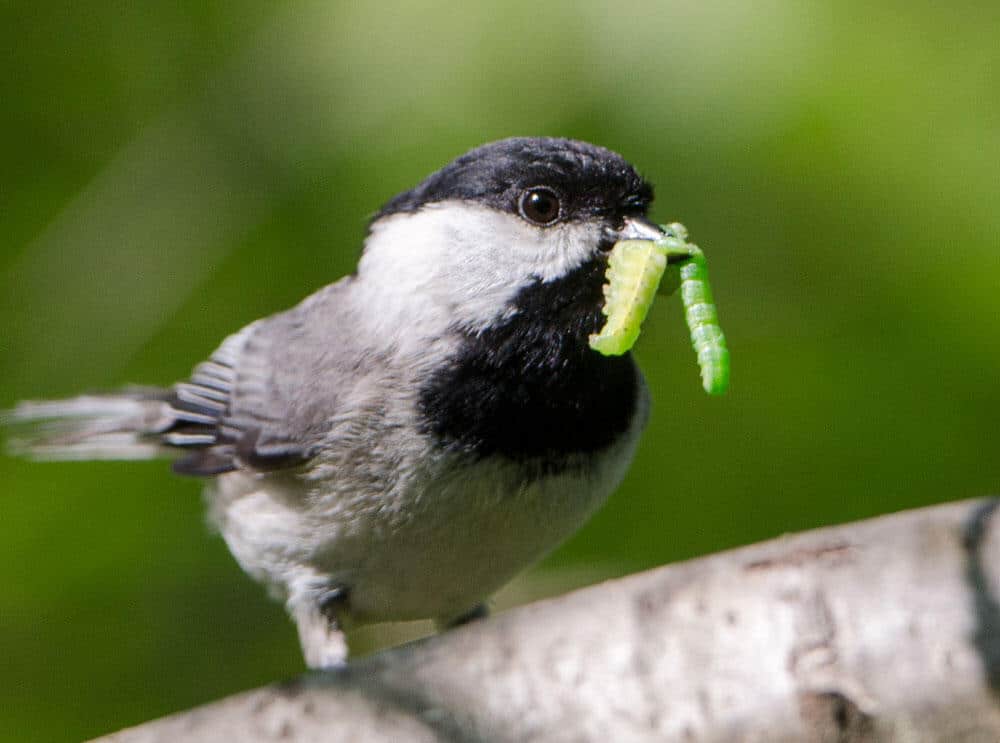
If you think eastern bluebirds are cute, you’ll love black-capped chickadees. They don’t have bluish bodies, but their gray, black, and white combos make these small birds look stunning.
A black-capped chickadee has an elegant black cap on its large head, and white cheeks separate the head cap from the black bib.
These resident birds inhabit the deciduous forests and cottonwood groves of northern states, including NH, when they’re not eating sunflower seeds in backyards.
Have you spotted these 21 species? Since you either spot birds in your backyard or visit public birding locations, let’s discuss how to attract more birds to feeders and where you can go birding in NH.
The Best Birding Locations In New Hampshire
There are many habitats here, from salt marshes to tundra forests. Hence, this state has diverse birdlife, including shorebirds, sparrows, and finches. Here are places you ought to visit first.
1. Odiorne Point State Park, Rye
It’s where you’ll experience the beauty of this state and the many habitats it has to offer residents and migratory birds because this park enjoys a strip of the shoreline. Birds to see here include winter visitors like the purple sandpiper and the red-throated loon. In the fall, migratory raptors, including the sharp-shinned hawks and bald eagles, stop by as they fly south.
2. Great Bay National Wildlife Refuge
This expansive conservation area was formerly an airport, and it has hiking trails for you to explore its 1,000 acres looking for different avian species. Expect sightings of the eastern bluebird, osprey, pileated woodpecker, pine warbler, and bald eagle.
3. Hampton Beach State Park
Summer months spent here let you combine birding watching with endless hours in the sun. Although there are no hiking trails, you’ll see most birds as you walk up and down the beach. Some common sightings include the snow bunting, purple sandpiper, black guillemot, snowy owl, and the horned lark.
4. Mount Washington State Park
With White Mountain National Forest adjacent to this attraction, expect nothing short of an unforgettable birding tour in the 60-acre park. Common birds in this park include the gray jay, golden-crowned kinglet, blackburnian, and Canada warblers.
How To Attract Backyard Birds In NH
1. Install A Range Of Bird Feeders
We talked about ground feeders, aggressive birds that harass tiny avians, plus others that love sugar water. All of these are situations that call for separate feeders.
2. Avoid Pesticides & Herbicides
Some species only come for weed seeds or insects. When you destroy such food, you push them away. Additionally, the chemicals in these products may have far-reaching effects on avians.
3. Install Nest Boxes
We talked about a few birds that come to NH during the breeding season. Such visitors can use your nest boxes if they’re cavity nesters.
4. Grow Brush Piles & Native Plants
Native plants like elderberry and dogwood are food for some birds. Additionally, brush piles increase insects in your yard, so you’ll attract more house wrens.
5. Provide Clean Water
You could install a fountain where birds can bathe and drink. One of the disadvantages of water features is that avians contaminate the water with droppings and seeds. Therefore, you either install a fountain without perches or clean it regularly to remove droppings.
Watch This!
Frequently Asked Questions
What is the rarest bird in New Hampshire?
Rare birds sighted recently are the green-winged teal, king eider, and the stilt sandpiper. Birders report seeing them in Hampton Salt Marsh Conservation Area, Meadow Pond, and Pickering Ponds. You may want to add these locations to your birding destinations.
How many species of birds are in New Hampshire?
In 2020, there were about 275 resident species and 85 migratory or wintering birds.
Among the species you’ll see daily are the American robin, black-capped chickadee, blue jay, northern cardinal, and song sparrow.
It’s an eastern state, close to the breeding range of birds that nest in Canada and the northernmost parts of the continent.
Further, there are migratory birds like the ruby-throated hummingbird and species found in eastern states only, such as the eastern bluebird. New Hampshire might be a small state compared to Texas and California, but its avian wealth is in no way insignificant.
Are there cardinals in New Hampshire?
Yes, this ground-feeding bird is a common backyard bird in NH.
Conclusion
With over 300 birds in NH, the birding experience is better when you know field markings to differentiate between resident and migratory avians.
Therefore, we’ve listed common birds and their features to get you started. We also told you a few locations with sightings of both resident and migratory birds.
Remember, this state’s location in the east while enjoying a bit of the Atlantic shore on the southwestern edge, makes it a habitat for shorebirds you may not see in the middle states.

